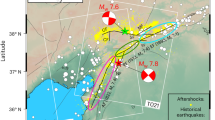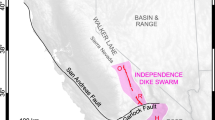Abstract
Segmentation can influence the extent of earthquake rupture and event magnitude1: large megathrust earthquakes result from total rupture of relatively continuous segments of the subduction interface2,3,4,5. Segmentation is attributed to variations in the frictional properties of the seismogenic zone or to topographic features on the down-going plate6,7,8,9. Structures in the overriding plate may also influence segmentation10,11,12,13, but their importance has been dismissed. Here, we investigate the links between interface segmentation at the North Chile seismic gap14 and a crustal-scale fault structure in the overriding plate that forms a coastal scarp of about 1 km in height10,15. We use satellite interferometric synthetic aperture radar (InSAR) and Global Positioning System (GPS) data to measure interseismic surface deformation between 2003 and 2009 and compare the deformation with rupture extent during well-documented earthquakes5,16,17,18. From these data we infer the degree of coupling and segmentation at depth. We find that along a 500-km-long segment, the base of the strongly coupled seismogenic zone correlates with the line of the surface coastal scarp and follows the outline of the Mejillones Peninsula. This correlation implies that large-scale structures in the overriding plate can influence the frictional properties of the seismogenic zone at depth. We therefore suggest that the occurrence of megathrust earthquakes in northern Chile is controlled by the surface structures that build Andean topography.
This is a preview of subscription content, access via your institution
Access options
Subscribe to this journal
Receive 12 print issues and online access
$259.00 per year
only $21.58 per issue
Buy this article
- Purchase on Springer Link
- Instant access to full article PDF
Prices may be subject to local taxes which are calculated during checkout




Similar content being viewed by others
References
Scholz, C. H. Scaling laws for large earthquakes: Consequences for physical models. Bull. Seismol. Soc. Am. 72, 1–14 (1982).
Ruegg, J. C. et al. Interseismic strain accumulation measured by GPS in the seismic gap between Constitucioń and Concepcioń in Chile. Phys. Earth Planet. Inter. 175, 78–85 (2009).
Moreno, M., Rosenau, M. & Oncken, O. Maule earthquake slip correlates with pre-seismic locking of Andean subduction zone. Nature 467, 198–202 (2010).
Loveless, J. P. & Meade, B. J. Spatial correlation of interseismic coupling and coseismic rupture extent of the 2011 Mw = 9.0 Tohoku-oki earthquake. Geophys. Res. Lett. 38, L17306 (2011).
Chlieh, M. et al. Interseismic coupling and seismic potential along the Central Andes subduction zone. J. Geophys. Res. 116, B12405 (2011).
Hetland, E. A & Simons, M. Post-seismic and interseismic fault creep II: Transient creep and interseismic stress shadows on megathrusts. Geophys. J. Int. 181, 99–112 (2010).
Métois, M., Socquet, A. & Vigny, C. Interseismic coupling, segmentation and mechanical behaviour of the Central Chile subduction zone. J. Geophys. Res. 117, B03406 (2012).
Kodaira, S. et al. Structural factors controlling the rupture process of a megathrust earthquake at the Nankai trough seismogenic zone. Geophys. J. Int. 149, 815–835 (2002).
Wang, K. & Bilek, S. L. Do subducting seamounts generate or stop earthquakes? Geology 39, 819–822 (2011).
Armijo, R. & Thiele, R. Active faulting in Northern Chile: Ramp stacking and lateral decoupling along a subduction plate boundary? Earth Planet. Sci. Lett. 98, 40–61 (1990).
Song, T. R. A. & Simons, M. Large trench-parallel gravity variations predict seismogenic behavior in subduction zones. Science 301, 630–633 (2003).
Wells, R. E., Blakely, R. J., Sugiyama, Y., Scholl, D. W. & Dinterman, P. A. Basin-centered asperities in great subduction zone earthquakes: A link between slip, subsidence, and subduction erosion? J. Geophys. Res. 108, 2507 (2003).
Loveless, J. P., Pritchard, M. E. & Kukowski, N. Testing mechanisms of seismic segmentation with slip distributions from recent earthquakes along the Andean margin. Tectonophysics 495, 15–33 (2010).
Comte, D. & Pardo, M. Reappraisal of great historical earthquakes in the northern Chile and southern Peru seismic gaps. Nat. Hazards 4, 23–44 (1991).
Contreras-Reyes, E., Jara, J., Grevemeyer, I., Ruiz, S. & Carrizo, D. Abrupt change in the dip of the subducting plate beneath north Chile. Nature Geosci. 5, 342–345 (2012).
Chlieh, M. et al. Crustal deformation and fault slip during the seismic cycle in the North Chile subduction zone, from Global Positioning System and InSAR observations. Geophys. J. Int. 158, 695–711 (2004).
Pritchard, M. E. & Simons, M. An aseismic slip pulse in northern Chile and along-strike variations in seismogenic behavior. J. Geophys. Res. 111, B08405 (2006).
Béjar-Pizarro, M. et al. Asperities, barriers and transition zone in the North Chile seismic gap: State of the art after the 2007 Mw 7.7 Tocopilla earthquake inferred by GPS and InSAR data. Geophys. J. Int. 183, 390–406 (2010).
Vigny, C. et al. The 2010 Mw 8.8 Maule Megathrust Earthquake of Central Chile, Monitored by GPS. Science 332, 1417–1421 (2011).
Singh, S. C. et al. Aseismic zone and earthquake segmentation associated with a deep subducted seamount in Sumatra. Nature Geosci. 4, 308–311 (2011).
Fuller, C. W., Willett, S. D. & Brandon, M. T. Formation of forearc basins and their influence on subduction zone earthquakes. Geology 34, 65–68 (2006).
Vigny, C. et al. Upper plate deformation measured by GPS in the Coquimbo Gap, Chile. Phys. Earth Planet. Int. 175, 86–95 (2009).
Armijo, R. et al. The West Andean Thrust, the San Ramón Fault, and the seismic hazard for Santiago, Chile. Tectonics 29, TC2007 (2010).
Adam, J. & Reuther, C. D. Crustal dynamics and active fault mechanics during subduction erosion. Application of frictional wedge analysis on to the North Chilean Forearc. Tectonophysics 321, 297–325 (2000).
Savage, J. A dislocation model of strain accumulation and release at a subduction zone. J. Geophys. Res. 88, 4984–4996 (1983).
Bevis, M. et al. On the strength of interplate coupling and the rate of back arc convergence in the central Andes: An analysis of the interseismic velocity field. Geochem. Geophys. Geosyst. 2, GC000198 (2001).
Khazaradze, G. & Klotz, J. Short- and long-term effects of GPS measured crustal deformation rates along the south central Andes. J. Geophys. Res. 108, 2289 (2003).
Simons, M. et al. The 2011 Magnitude 9.0 Tohoku-Oki earthquake: Mosaicking the megathrust from seconds to centuries. Science 322, 1421–1425 (2011).
Wesnousky, S. G. Predicting the endpoints of earthquake ruptures. Nature 444, 358–360 (2006).
Fournier, T. J., Pritchard, M. E. & Finnegan, N. J. Accounting for atmospheric delays in InSAR data in a search for long wavelength deformation in South America. IEEE Trans. Geosci. Remote Sens. 49, 3856–3867 (2011).
Acknowledgements
This work was performed in the frame of the French/Chilean international collaboration (CNRS/CONICYT LIA ‘Montessus de Ballore’). We thank the European Space Agency (ESA) for providing the ENVISAT images (project AO-720). This work was made possible thanks to the funding of the French National Research Agency (ANR-05-CATT-014, ANR-06-CATT-010-01), CNRS/INSU PNTS project, BQR IPGP and the LABEX UnivEarthS (Sorbonne Paris Cité, IPGP). Development and analysis of the CAnTO GPS network was partly supported by the Gordon and Betty Moore Foundation. We are very grateful to the many people who contributed to the development and maintenance of the permanent GPS network in North Chile and the associated database, in particular C. Aranda, S. Barrientos, J. Campos, J. B. de Chabalier, O. Charade, D. Comte, A. Delorme, B. Glass, J. Galetzka, E. Maureira, A. Nercessian, M. Olcay, I. Ortega, J. C. Ruegg, C. Valderas-Bermejo and C. Vigny.
Author information
Authors and Affiliations
Contributions
M.B-P. processed InSAR data, analysed InSAR and cGPS time-series, and did the modelling. A.S. designed the study, collected the GPS data, and supervised geodetic analysis and modelling. R.A. did the geomorphologic analysis and geological interpretation. D.C. collected the GPS data and contributed to the geological interpretation. J.G. collected and processed GPS data. M.S. contributed to the data collection, geodetic analysis and modelling. The paper was co-written by A.S., R.A. and M.B-P. All authors discussed the results and commented on the paper.
Corresponding author
Ethics declarations
Competing interests
The authors declare no competing financial interests.
Supplementary information
Supplementary Information
Supplementary Information (PDF 26318 kb)
Rights and permissions
About this article
Cite this article
Béjar-Pizarro, M., Socquet, A., Armijo, R. et al. Andean structural control on interseismic coupling in the North Chile subduction zone. Nature Geosci 6, 462–467 (2013). https://doi.org/10.1038/ngeo1802
Received:
Accepted:
Published:
Issue Date:
DOI: https://doi.org/10.1038/ngeo1802
This article is cited by
-
Possible Seismic Source Mechanism of the Catastrophic Tsunamigenic Earthquake on May 9, 1877 in Northwestern Chile
Pure and Applied Geophysics (2023)
-
Constraining tectonic uplift and advection from the main drainage divide of a mountain belt
Nature Communications (2021)
-
Contribution of background seismicity to forearc uplift
Nature Geoscience (2021)
-
Rupture parameter sensitivity of low frequency ground motion response spectra using synthetic scenarios in North Chile
Bulletin of Earthquake Engineering (2021)
-
Tsunami Modeling in the South American Subduction Zone Inferred from Seismic Coupling and Historical Seismicity
Pure and Applied Geophysics (2021)



